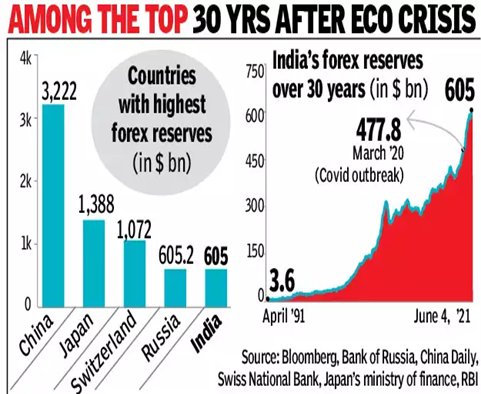In News:
- The Reserve Bank of India (RBI) added another 58 tonnes of gold to India's foreign exchange (forex) basket during the six months ending March 2022, bringing the country's gold holdings to 760.42 tonnes.
- The RBI's gold acquisition came at a time when foreign portfolio investors (FPIs) were leaving India and India's forex reserves fell by $44.73 billion (from $642.45 billion in September 2021 to $597.72 billion on April 29, 2022).
What’s in today’s article:
- Forex Reserves (About, objectives)
- Forex Reserves in India (Where is it kept, cost of maintaining reserves, significance of maintaining reserves)
- News Summary (India’s gold reserves, importance)
Foreign Exchange (forex) Reserves:

- About: Forex reserves are external assets in the form of gold, special drawing rights (SDRs) and Reserve position of the International Monetary Fund (IMF) and foreign currency assets accumulated by India and controlled by the Reserve Bank of India.
- The foreign currency assets (largest component of forex reserve in India) include capital inflows to the capital markets, Foreign Direct Investment (FDI) and external commercial borrowings (ECB).
- Objectives: According to the IMF, forex reserves are held by a country to fulfill objectives like -
- Encourage and sustain trust in monetary and exchange rate management policies, including the ability to intervene in support of national or union currency.
- It will also reduce external vulnerability through the maintenance of foreign currency liquidity to absorb shocks during crisis periods or when access to credit is reduced.
- Where is it kept?
- The RBI functions as the custodian and manager of forex reserves and operates within the overall policy framework agreed upon with the government.
- The RBI Act of 1934 establishes an overall legal framework for deploying reserves in various foreign currency assets and gold.
- According to the RBI data, as much as 64% of the foreign currency reserves are held in securities like Treasury bills of foreign countries (mainly USD), 28% is deposited in foreign central banks and 4% is also deposited in foreign commercial banks.
- India also possessed 760.42 tonnes of gold (as of March 2022). Out of this, 453.52 tonnes of gold are held overseas in safe custody with the Bank of England and the Bank of International Settlements, while 295.82 tonnes are held domestically.
- Cost of maintaining forex reserves:
- The return on India's forex reserves (held in foreign central banks and commercial banks) is insignificant.
- Although RBI did not report forex investment returns, analysts estimate it might be approximately 1% or even less.
- There were demands to utilize forex reserves in India's infrastructure development, but the RBI opposed the plan.
- Another issue is the high ratio (80%) of volatile flows (portfolio flows and short-term debt) to reserves, which can exit the Indian economy at a fast pace.
- Significance of maintaining forex reserves:
- RBI allocates the dollars for specific purposes: For example, under the Liberalised Remittances Scheme (LRS), individuals are allowed to remit up to $250,000 every year.
- For the management of the Indian rupee: It sells the dollar when the rupee weakens and buys the dollar when the rupee strengthens.
News Summary:
- India’s gold reserves:
- According to the RBI's Report on Foreign Exchange Reserve Management, India’s gold holdings have now gone up by 65.11 tonnes from 695.31 tonnes (total = 760.42 tonnes) in March 2021, making India the ninth-largest holder of gold reserves.
- The value of the RBI’s holdings has gone up by $5.162 billion in six months to $42.55 billion as of March 2022.
- Importance of gold reserves:
- While gold no longer plays a direct role in the international monetary system, central banks are increasingly buying gold.
- Gold is the world's third largest reserve asset, trailing only US dollars and euros.
- Central banks and governments continue to retain substantial gold reserves in order to preserve national wealth and defend against economic instability.
- According to the World Gold Council (WGC), it is also increasingly utilized as collateral in financial transactions, similar to other high-quality, liquid assets such as government debt.
- In case of India:
- Gold has long formed an important part of India’s currency reserves.
- A sizeable gold holding is expected to add stability to the forex reserves at a time when capital outflows are putting pressure on India’s reserves.









